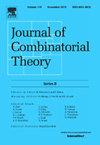Hyperbolicity theorems for correspondence colouring
IF 1.2
1区 数学
Q1 MATHEMATICS
引用次数: 0
Abstract
We generalize a framework of list colouring results to correspondence colouring. Correspondence colouring is a generalization of list colouring wherein we localize the meaning of the colours available to each vertex. As pointed out by Dvořák and Postle, both of Thomassen's theorems on the 5-choosability of planar graphs and 3-choosability of planar graphs of girth at least five carry over to the correspondence colouring setting. In this paper, we show that the family of graphs that are critical for 5-correspondence colouring as well as the family of graphs of girth at least five that are critical for 3-correspondence colouring form hyperbolic families. Analogous results for list colouring were shown by Postle and Thomas and by Dvořák and Kawarabayashi, respectively. Using results on hyperbolic families due to Postle and Thomas, we show that this implies that there exists a universal constant c such that if Σ is a surface of Euler genus g, every graph of edge-width at least embedded in Σ is 5-correspondence colourable. This is asymptotically best possible, and improves upon the best known edge-width bound due to Kim, Kostochka, Li, and Zhu. Using results of Dvořák and Kawarabayashi, we show further that there exist linear-time algorithms for the decidability of 5-correspondence colouring for embedded graphs. We show analogous results for 3-correspondence colouring graphs of girth at least five.
对应着色的双曲性定理
我们将列表着色结果的框架推广到对应着色。对应着色是列表着色的一种推广,其中我们对每个顶点可用的颜色的含义进行局部化。Dvořák和Postle指出,托马森关于平面图形的5-可选性定理和周长至少为5的平面图形的3-可选性定理都适用于对应着色设置。本文证明了5对应着色的临界图族和周长至少为5的3对应着色的临界图族构成双曲族。Postle和Thomas以及Dvořák和Kawarabayashi分别给出了列表着色的类似结果。利用Postle和Thomas关于双曲族的结果,我们证明了这意味着存在一个普适常数c,使得如果Σ是欧拉属g的曲面,则嵌入Σ中的每个边宽至少为c⋅log (g+1)的图都是5对应可着色的。这是渐近最佳可能,并且改进了Kim、Kostochka、Li和Zhu给出的最著名的边宽界。利用Dvořák和Kawarabayashi的结果,我们进一步证明了嵌入图的5对应着色的可判定性存在线性时间算法。我们给出了周长至少为5的3对应着色图的类似结果。
本文章由计算机程序翻译,如有差异,请以英文原文为准。
求助全文
约1分钟内获得全文
求助全文
来源期刊
CiteScore
2.70
自引率
14.30%
发文量
99
审稿时长
6-12 weeks
期刊介绍:
The Journal of Combinatorial Theory publishes original mathematical research dealing with theoretical and physical aspects of the study of finite and discrete structures in all branches of science. Series B is concerned primarily with graph theory and matroid theory and is a valuable tool for mathematicians and computer scientists.

 求助内容:
求助内容: 应助结果提醒方式:
应助结果提醒方式:


